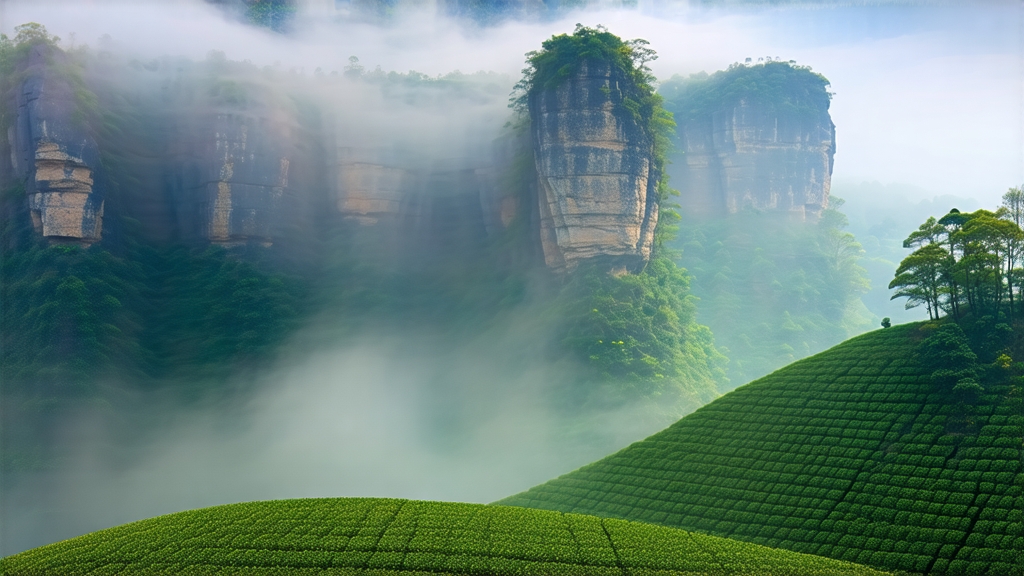
When travelers first glimpse the sheer sandstone cliffs of northern Fujian’s Wuyi Mountains, they often assume the vertiginous landscape is uninhabitable. Yet it is precisely those sun-warmed, mineral-laden crevices that cradle the mother bushes of Da Hong Pao—literally “Big Red Robe”—the most mythic oolong on earth. For four centuries this tea has carried the aroma of pine smoke, orchids and wet stone across oceans, becoming both a diplomatic gift and a collector’s obsession. To understand Da Hong Pao is to taste the chemistry of igneous rock, the patience of charcoal masters, and the poetry of an empire that once wrapped four surviving bushes in imperial scarlet.
Origin and legend
The name first appears in Ming-dynasty county records from 1655, but folklore pushes the story back to 1385. A Ming court scholar, stricken with fever while passing the Wuyi Nine-Dragon Gorge, was revived by a brew made from tea leaves plucked halfway up the cliff. Upon recovery he placed his own crimson imperial robe over the bushes to protect them from the mountain wind. The grateful emperor later decreed that each spring the entire harvest be sent to the palace, beginning a tradition of tribute that continued until 1911. Whether apocryphal or not, the tale explains both the evocative name and the mystique that still justifies record-breaking auction prices—30 g of 1920s mother-bush leaf sold for USD 1.2 million in 2005.
Terroir: why “rock-essence” matters
Wuyi’s Danxia landform is a 350-million-year-old riverbed lifted into the sky. Iron-rich sandstone and tuff weather into thin, gravelly soils that force tea roots to probe fissures for micronutrients. The gorge traps morning fog, creating a humid microclimate that slows photosynthesis and concentrates amino acids. Locals speak of yan yun—“rock rhyme”—a tactile minerality that lingers in the throat like the after-tone of a bronze bell. Only leaf plucked within the 60 km² core scenic zone may legally bear the designation Zheng Yan (“true cliff”), a geographic pedigree akin to Champagne in France.
Cultivars: six famous bushes and their offspring
The original mother grove consisted of six genetically distinct bushes: Qi Dan, Bei Dou, Que She, Ya Shi, Tie Luo Han and Bai Ji Guan. Cuttings taken in the 1980s produced the so-called “purebred” or qizhong (clones) now cultivated on terraced shelves throughout the reserve. Gardeners also graft selected scions onto stronger rootstocks, creating grafted Da Hong Pao (sajiao) that retain mother-bush character while yielding 400 kg per hectare instead of 2 kg. Finally, commercial blends marry leaf from several Wuyi cultivars to recreate the classic profile at accessible prices; these are labeled simply “Da Hong Pao” without clonal detail.
Harvest calendar
Spring picking begins when 50 % of the buds show fish-leaf unfold, usually between 20 April and 5 May. Only the top three leaves and the tender bud are taken, ideally before 10 a.m. while dew still guards against bruising. A second, lighter autumn pick occurs in mid-October, yielding leaf with higher aromatics but thinner body. Summer leaf is never picked; the bushes are allowed to store carbohydrates for winter.
Crafting the cliff tea: nine steps that take three months
- Wilting: baskets of leaf are wheeled onto rocky ledges to sun-wilt for 20–30 minutes, until the edges turn matte.
- Indoor withering: shaken every hour onto bamboo sieves for 6–8 h to bruise cell walls and initiate oxidation.
- Green shaking: the signature “yaoqing”—rhythmic tossing in a rattan drum—repeats five to seven times through the night, coaxing enzymes to convert catechins into theaflavins.
- Fixing: wok-firing at 240 °C for 7 minutes halts oxidation at 30–40 %, preserving the half-green, half-amber character.
- Rolling: the hot leaf is wrapped in cloth and rolled into tight strips that will unfurl like dragon whiskers during brewing.
- Initial roasting: charcoal embers at 100 °C bake the leaf for 2 h, reducing moisture to 20 %.
- Sorting and stem-picking: artisans remove old stems